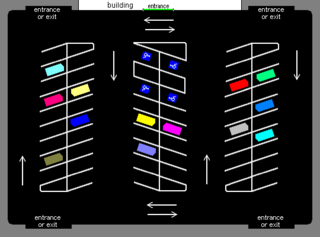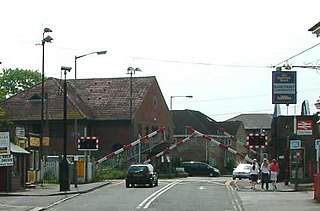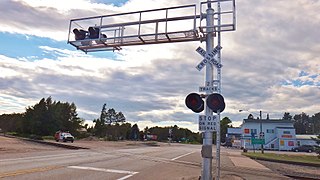
A toll road, also known as a turnpike or tollway or toll gate, is a public or private road for which a fee is assessed for passage. It is a form of road pricing typically implemented to help recoup the costs of road construction and maintenance.
Radio-frequency identification (RFID) uses electromagnetic fields to automatically identify and track tags attached to objects. An RFID system consists of a tiny radio transponder, a radio receiver and transmitter. When triggered by an electromagnetic interrogation pulse from a nearby RFID reader device, the tag transmits digital data, usually an identifying inventory number, back to the reader. This number can be used to track inventory goods.

Electronic toll collection (ETC) is a wireless system to automatically collect the usage fee or toll charged to vehicles using toll roads, HOV lanes, toll bridges, and toll tunnels. It is a faster alternative which is replacing toll booths, where vehicles must stop and the driver manually pays the toll with cash or a card. In most systems, vehicles using the system are equipped with an automated radio transponder device. When the vehicle passes a roadside toll reader device, a radio signal from the reader triggers the transponder, which transmits back an identifying number which registers the vehicle's use of the road, and an electronic payment system charges the user the toll.

A parking lot or car park, also known as a car lot, is a cleared area intended for parking vehicles. The term usually refers to an area dedicated only for parking, with a durable or semi-durable surface. In most jurisdictions where cars are the dominant mode of transportation, parking lots are a major feature of cities and suburban areas. Shopping malls, sports stadiums, megachurches and similar venues often have immense parking lots.

A conventional fixed-wing aircraft flight control system (AFCS) consists of flight control surfaces, the respective cockpit controls, connecting linkages, and the necessary operating mechanisms to control an aircraft's direction in flight. Aircraft engine controls are also considered as flight controls as they change speed.

A bollard is a sturdy, short, vertical post. The term originally referred to a post on a ship or quay used principally for mooring boats. It now also refers to posts installed to control road traffic and posts designed to prevent automotive vehicles from colliding or crashing into pedestrians and structures.

Drive by wire or DbW technology in the automotive industry is the use of electronic or electro-mechanical systems in place of mechanical linkages that control driving functions. The concept is similar to fly-by-wire in the aviation industry. Drive-by-wire may refer to just the propulsion of the vehicle through electronic throttle control, or it may refer to electronic control over propulsion as well as steering and braking, which separately are known as steer by wire and brake by wire, along with electronic control over other vehicle driving functions.

The automated manual transmission (AMT) is a type of transmission for motor vehicles. It is essentially a conventional manual transmission equipped with automatic actuation to operate the clutch and/or shift gears.

Union Switch & Signal was an American company based in Pittsburgh, Pennsylvania, which focused on railway signaling equipment, systems and services. The company was acquired by Ansaldo STS in 1988, operating as a wholly-owned company until January 2009, when US&S was renamed "Ansaldo STS USA" to operate as a subsidiary of Ansaldo in the Americas and Asia.

In road vehicles, the parking brake, also known as a handbrake or emergency brake (e-brake), is a mechanism used to keep the vehicle securely motionless when parked. Parking brakes often consist of a pulling mechanism attached to a cable which is connected to two wheel brakes. In most vehicles, the parking brake operates only on the rear wheels, which have reduced traction while braking. The mechanism may be a hand-operated lever, a straight pull handle located near the steering column, or a foot-operated pedal located with the other pedals.

A four-quadrant gate or full-barrier equipment is a type of boom barrier gate protecting a grade crossing. It has a gate mechanism on both sides of the tracks for both directions of automotive traffic. The exit gates blocking the road leading away from the tracks are equipped with a delay, and begin their descent to their horizontal position several seconds after the entrance gates do, so as to avoid trapping highway vehicles on the crossing. In the United Kingdom, the exit-side barriers do not lower until the entrance-side barriers have lowered.
A keycard lock is a lock operated by a keycard, a flat, rectangular plastic card. The card typically, but not always, has identical dimensions to that of a credit card or American and EU driver's license. The card stores a physical or digital pattern that the door mechanism accepts before disengaging the lock.

Salik is the name given to the electronic toll road system in Dubai, United Arab Emirates, which is based on RFID technology, automatically deducting a fee when a toll gate is passed under. The Salik toll was launched by Dubai's Dubai Roads and Transport Authority (RTA) on 1 July 2007.

Automatic block signaling (ABS), spelled automatic block signalling or called track circuit block (TCB) in the UK, is a railroad communications system that consists of a series of signals that divide a railway line into a series of sections, called blocks. The system controls the movement of trains between the blocks using automatic signals. ABS operation is designed to allow trains operating in the same direction to follow each other in a safe manner without risk of rear-end collision.

Railway semaphore signal is one of the earliest forms of fixed railway signals. This semaphore system involves signals that display their different indications to train drivers by changing the angle of inclination of a pivoted 'arm'. Semaphore signals were patented in the early 1840s by Joseph James Stevens, and soon became the most widely used form of mechanical signal. Designs have altered over the intervening years, and colour light signals have replaced semaphore signals in most countries, but in a few they remain in use.

Level crossing signals are the electronic warning devices for road vehicles at railroad level crossings.

In engineering, electromechanics combines processes and procedures drawn from electrical engineering and mechanical engineering. Electromechanics focuses on the interaction of electrical and mechanical systems as a whole and how the two systems interact with each other. This process is especially prominent in systems such as those of DC or AC rotating electrical machines which can be designed and operated to generate power from a mechanical process (generator) or used to power a mechanical effect (motor). Electrical engineering in this context also encompasses electronics engineering.
Automatic Systems, a subsidiary of Bolloré Group, is a company, specialising in the automation of secure entrance control. The company designs and manufactures vehicle, pedestrian and passenger access control equipment. According to the IMS research, titled "The World Market for Pedestrian Entrance Control Equipment" (2013), Automatic Systems is ranked No. 1 as speed gates supplier for Mass Transit Applications in the world and for Intrabuilding in EMEA. Headquartered in Wavre, the Belgian province of the Walloon Brabant situated close to Brussels, the capital of Belgium, Automatic Systems operates through its subsidiaries located in France, the UK, Spain, Canada and the USA. and a network of worldwide distributors. The company exports 90% of its production through a network of international distribution partners. Its net sales topped €71.9 million in 2016.

There are around 6,000 level crossings in the United Kingdom, of which about 1,500 are public highway crossings. This number is gradually being reduced as the risk of accidents at level crossings is considered high. The director of the UK Railway Inspectorate commented in 2004 that "the use of level crossings contributes the greatest potential for catastrophic risk on the railways." The creation of new level crossings on the national network is banned, with bridges and tunnels being the more favoured options. The cost of making significant reductions, other than by simply closing the crossings, is substantial; some commentators argue that the money could be better spent. Some 5,000 crossings are user-worked crossings or footpaths with very low usage. The removal of crossings can improve train performance and lower accident rates, as some crossings have low rail speed limits enforced on them to protect road users. In fact, between 1845 and 1933, there was a 4 miles per hour (6.4 km/h) speed limit on level crossings of turnpike roads adjacent to stations for lines whose authorising Act of Parliament had been consolidated in the Railways Clauses Consolidation Act 1845 although this limit was at least sometimes disregarded.
Designs of level crossings, where railway lines cross roads or other paths, vary country-to-country.


















